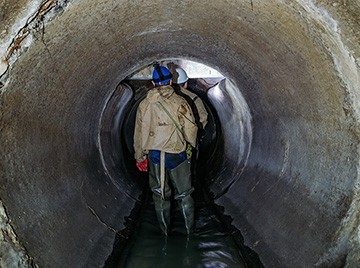FOR IMMEDIATE RELEASE
ACS News Service Weekly PressPac: February 09, 2022
Sewer slime can hang on to SARS-CoV-2 RNA from wastewater
“Accumulation of SARS-CoV‑2 RNA in Sewer Biofilms”
ACS ES&T Water
During the COVID-19 pandemic, monitoring the levels of SARS-CoV-2 RNA in wastewater entering treatment plants has been one way that researchers have gauged the disease’s spread. But could the slimy microbial communities that line most sewer pipes affect the viral RNA they encounter? In a first-of-its-kind study, researchers report in ACS ES&T Water that sewer slime can accumulate SARS-CoV-2 RNA, which could decompose or slough off later, potentially impacting the accuracy of wastewater epidemiology studies.
As the water and sludge from people’s homes converge in sewers, some of the solids settle out, and gooey microbial biofilms build up within the pipes. Previous researchers have shown that RNA viruses, such as poliovirus, enteroviruses and noroviruses, can get trapped and collect in this slime. Yet whether the sticky material can also accumulate SARS-CoV-2 viral particles or RNA from wastewater is unknown. Nicole Fahrenfeld and colleagues previously detected the virus’s RNA in sewer deposits from a university dormitory with a low number of COVID-19 cases, but the amount was too low to accurately assess. So, the team wanted to see if biofilms could incorporate SARS-CoV-2 RNA from untreated wastewater during times of low and high COVID-19 incidence.
To grow a simulated sewer slime, the researchers continuously pumped raw wastewater into a cylindrical tank with removable pieces of polyvinyl chloride (PVC) inside. They conducted two 28-day experiments, removing PVC plates every few days to assess the biofilm’s composition. Then the team used the method called reverse transcription quantitative polymerase chain reaction to measure the abundance of SARS-CoV-2 RNA and pepper mottle virus (an indicator of human feces) RNA in the untreated wastewater and the biofilms.
In August and September 2020, the levels of SARS-CoV-2 RNA were too low to accurately measure in both the simulated sewer slime and the wastewater from which it grew. These results align with a low incidence of COVID-19 infections at that time, the researchers say. Then, during November and December 2020, although SARS-CoV-2’s presence in the wastewater itself was still low, its RNA levels increased in the slime. The amount of pepper mottle virus RNA plateaued within the first week of growth, indicating that the rise of SARS-CoV-2 RNA in the biofilm wasn’t because of a boost in fecal volume. Rather, this change reflected the higher number of diagnosed COVID-19 cases in late fall. It’s still too early to know exactly how these biofilms impact wastewater epidemiology studies, since other factors need to be assessed first, say the researchers. For example, the RNA could get broken down, or it could be released into wastewater later on when the biofilms break apart.
The authors acknowledge funding from the U.S. National Science Foundation, the Rutgers Center for COVID-19 Response and Pandemic Preparedness and a Rutgers School of Graduate Studies Acceleration and Completion Fellowship.
###
The American Chemical Society (ACS) is a nonprofit organization chartered by the U.S. Congress. ACS’ mission is to advance the broader chemistry enterprise and its practitioners for the benefit of Earth and all its people. The Society is a global leader in promoting excellence in science education and providing access to chemistry-related information and research through its multiple research solutions, peer-reviewed journals, scientific conferences, eBooks and weekly news periodical Chemical & Engineering News. ACS journals are among the most cited, most trusted and most read within the scientific literature; however, ACS itself does not conduct chemical research. As a leader in scientific information solutions, its CAS division partners with global innovators to accelerate breakthroughs by curating, connecting and analyzing the world’s scientific knowledge. ACS’ main offices are in Washington, D.C., and Columbus, Ohio.
To automatically receive press releases from the American Chemical Society, contact newsroom@acs.org.
Note: ACS does not conduct research, but publishes and publicizes peer-reviewed scientific studies.
Media Contact
ACS Newsroom
newsroom@acs.org


